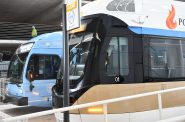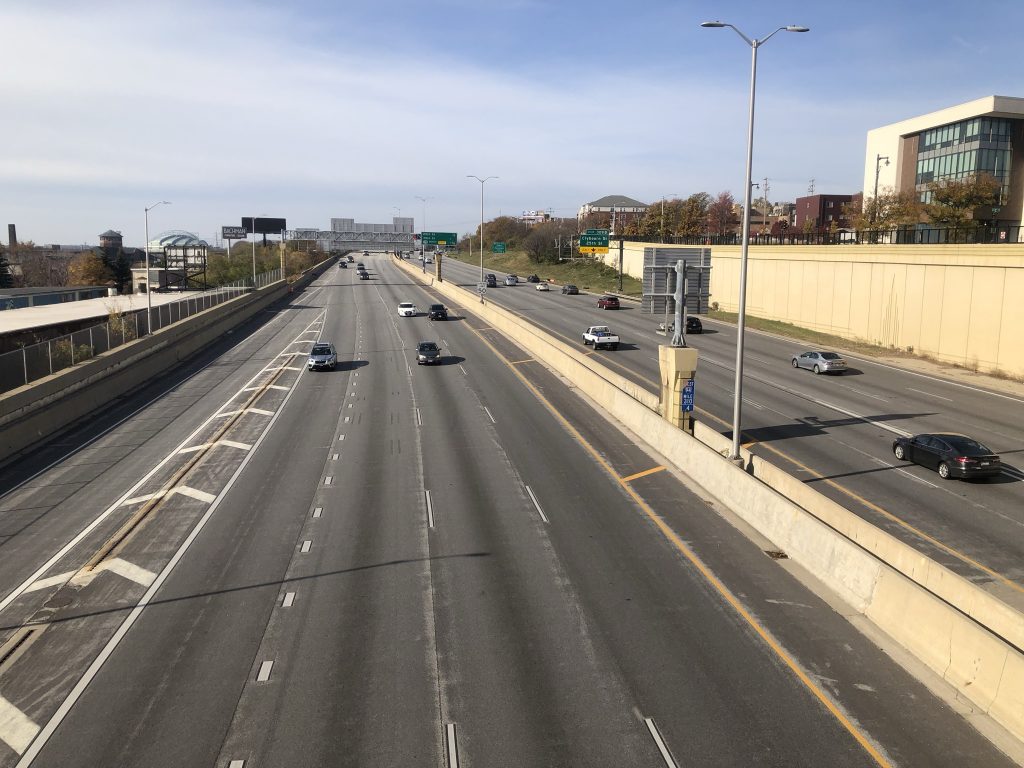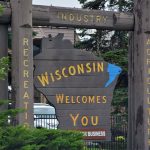I-94 Expansion Public Comment Deadline Extended
State allowing public comment until Jan. 31. Opponents favor "Fix at Six" option.
Have an opinion on the proposal to expand Interstate 94 between N. 16th St. and N. 70th St? The Wisconsin Department of Transportation (WisDOT) is giving the public more time to comment formally on the $1.2 billion project.
In November, WisDOT announced it was sticking with its earlier proposal for an expansion to eight lanes of the 3.5-mile corridor after studying a six-lane rebuild option. Both proposals called for replacing the Stadium Interchange near American Family Field with a smaller, diverging diamond design.
“Public involvement and coordination is a critical part of the I-94 East-West reevaluation process,” WisDOT Secretary Craig Thompson said. “Extending this comment period ensures all voices are heard as we work with stakeholders to minimize any impacts to the community. We remain committed to developing infrastructure solutions that benefit the public for decades to come.”
Comments can now be made in writing, through Jan. 31, on the WisDOT website. Additional comment methods are listed at the end of this article.
The project was initially shelved in 2017 for lack of funding, but Governor Tony Evers resurrected the project in 2020 and attempted to fast-track federal reapproval of a 2016 plan. In April 2021, state officials agreed to conduct a supplemental study to examine other options or traffic pattern changes. A community group proposed a “Fix at Six” strategy that included rebuilding the roadway with safety improvements, but not adding lanes.
WisDOT studied a six-lane configuration, but concluded it would cost approximately the same amount in large part because the total width of the freeway corridor and the design of the Stadium Interchange were nearly identical under both study options. And while WisDOT, in partnership with the Federal Highway Administration (FHWA), is now recommending the eight-lane option, it’s also recommending a different interchange with Wisconsin Highway 175 than was originally proposed in 2016.
The current interchange, built when the north-south corridor was expected to be a larger freeway, features completely grade-separated freeway ramps. But it includes left-hand exits and on-ramps, a design strategy no longer used in large part because of concerns about safety. The new right-side, eastbound exit to N. General Mitchell Boulevard, the western stadium ramp, would be substantially longer and loop under a portion of the new interchange. The westbound exit would also be much longer, with the combined on-off-ramp reconfiguration yielding new bridges that flank the sides of the interchange.
The now-completed supplemental study anticipates the final project would cost $1.2 billion in 2021 dollars. The six-lane option would cost $1.13 billion. Reverting either option to the larger interchange would add $80 million to the cost of the project. Construction on the project would start in 2025.
WisDOT said it would invest $25 million in “transit solutions” during the construction process to mitigate the impact. County officials have hoped to use some of the funding to support the development of the 27th Street bus rapid transit line. The project plan also calls for improved bicycle and pedestrian infrastructure near the freeway.
A study is still underway on converting a portion of Wisconsin Highway 175 to the north to a boulevard. A coalition is also advocating for converting a portion of Interstate 794 to a boulevard.
Project opponents and supporters were quick to criticize or promote WisDOT’s expansion proposal after it was announced in November.
“It is unacceptable that WisDOT has ignored the calls of thousands of Wisconsinites to fix the highway at six lanes and instead decided to move forward with an eight-lane proposal,” said Elizabeth Ward, director of Sierra Club Wisconsin Chapter. “This proposal will increase water and climate pollution, health problems, racial disparities, and more. WisDOT needs to reconsider and move forward with a Fix at Six solution.”
The pro-expansion I-94 East-West Econ Connect group praised the project.
“We thank WisDOT and FHWA for all the work they have done on this project,” said Corey Zetts, executive director of the Menomonee Valley Partners. “WisDOT analyzed the options using the latest data, continuously sought input from stakeholders, and has incorporated stakeholder feedback for improved bike and pedestrian facilities planned along the various local roadways as part of the project. This diligence will pay dividends for decades with a reduction in congestion-related traffic accidents and a corridor ready to keep up with the region’s bright future.”
The state will produce a final environmental impact statement based on the feedback and the federal government will issue a record of decision.
The completed study, formally the Supplemental Draft Environmental Impact Statement, is available on WisDOT’s website.
Comment Options
Comments can be submitted by using an online comment form, via email to joshua.leveque@dot.wi.gov, by phone to WisDOT Project Manager Josh LeVeque (414-750-1468) or by mail to:
Wisconsin Department of Transportation – Southeast Region
Attn: Josh LeVeque
141 NW Barstow, STE 218
PO Box 798, Waukesha, WI 53187-0798
More about the I-94 East-West Expansion
- Transportation: 27th Street Bridge Will Close For A Year - Graham Kilmer - Nov 29th, 2025
- Coalition Raises Concerns on I-94 Construction - Sierra Club - Nov 12th, 2025
- Construction Starting On $1.7 Billion Interstate 94 Widening - Jeramey Jannene - Oct 15th, 2025
- Governor Evers approves first segment of I-94 East-West construction to begin in Milwaukee County - Wisconsin Department of Transportation - Oct 15th, 2025
- Transportation: Fix At Six Coalition Sues State, Federal Government Over I-94 Expansion - Graham Kilmer - Aug 20th, 2024
- WisDOT to host I-94 East-West Freeway Project public meetings - Wisconsin Department of Transportation - Jun 12th, 2024
- Open Houses Announced For I-94 Widening - Jeramey Jannene - Jun 6th, 2024
- ‘Fix at Six’ Group Wants I-94 Expansion Delayed For Civil Rights Report - Jeramey Jannene - Mar 20th, 2024
- Coalition Admonishes I-94 expansion Record of Decision - Sierra Club - Mar 20th, 2024
- Feds Approve Interstate 94 Expansion - Jeramey Jannene - Mar 8th, 2024
Read more about I-94 East-West Expansion here
Political Contributions Tracker
Displaying political contributions between people mentioned in this story. Learn more.
Transportation
-
Congestion Pricing Cuts Air Pollution in New York City
 Dec 14th, 2025 by Jeff Wood
Dec 14th, 2025 by Jeff Wood
-
FTA Tells Milwaukee to Crack Down on Fare Evasion — Even Where Fares Don’t Exist
 Dec 12th, 2025 by Graham Kilmer
Dec 12th, 2025 by Graham Kilmer
-
Will GOGO’s Bus Service Ever Get Going?
 Dec 9th, 2025 by Jeramey Jannene
Dec 9th, 2025 by Jeramey Jannene





















For those who have not yet seen it, an article in today’s NYT adds firm support to those in opposition to widening urban
expressways,
That would be a front page above the fold article.
Here is a link to the NYT article:
https://www.nytimes.com/2023/01/06/us/widen-highways-traffic.html
The I-94 East-West Corridor Study does not provide adequate evidence that expanding the highway will achieve regional transportation goals, boost the economy, or be properly managed. It also lacks references to global practices and research (Litman, 2022, “Generated Traffic and Induced Travel,” Victoria Transport Policy Institute). Widening the highway will increase induced demand, leading to further capacity issues (Transportation for America, 2020 “The Congestion Con: How more lanes and more money equals more congestion”). This temporary fix damages communities and perpetuates an unsustainable cycle. Mass transit and modern technologies like Integrated Corridor Management (ICM) and Connected Vehicles (CV) can improve freight transit, and a mass transit approach is more suitable for the corridor’s population, jobs, and trip origins and destinations. A six-lane alternative with mass transit, local community consideration, and smart management should be developed by a new engineering team. The current team’s claim that doing nothing is not an option is deceptive and their refusal to consider a six-lane solution may violate ethical and legal standards. Continuing with an eight-lane expansion would waste taxpayer money, incur long-term costs, and cement a serious infrastructure mistake.
This is also a good article: Blumgart, Jake. (2022). Why the Concept of Induced Demand Is a Hard Sell: Both the public and policymakers have trouble understanding why building more roads and highways does not reduce congestion. Governing, February 28, 2022, https://www.governing.com/now/why-the-concept-of-induced-demand-is-a-hard-sell
Keep in mind that some of this induced demand comes from pulling traffic off of neighborhood streets, so it’s not a 100% negative thing. When I-94 backs up, many stream though neighborhoods on Bluemound and other parallel routes. Reducing that is a positive thing for these areas.
One of the challenges of this project is that the term “induced demand” is not well understood. It is counterintuitive to how people usually think about roads and traffic, but it has many decades of evidence confirming it. The people pushing for highway expansion thrive on this ignorance because they can bully people into misinformation about the term. Here is a good definition. Read also the articles at the right (“Related News about Induced Demand”) https://www.planetizen.com/definition/induced-demand
@CragR: No. Read the definition of induced demand. It points out the misconceptions arise when people think in terms of a static number of cars being present in a system after highway lane expansion, like water in a system of pipes. The better analogy is like a gas: the cars present increase to fill space available. There are many factors at play, but side streets will fill up once again, and perhaps even more so with adding more lanes to the freeway. Adding more lanes to the freeway to address congestion is like loosening your belt to address weight control.
The NY Times article explaining why highway expansion doesn’t solve congestion that was referenced in the first 2 posts (which I linked to in Post # 3) is behind a paywall that will keep some from seeing it. I found the same article text here (for free):
https://www.northbaybusinessjournal.com/article/news/widening-highways-doesnt-fix-traffic-so-why-do-we-keep-doing-it/